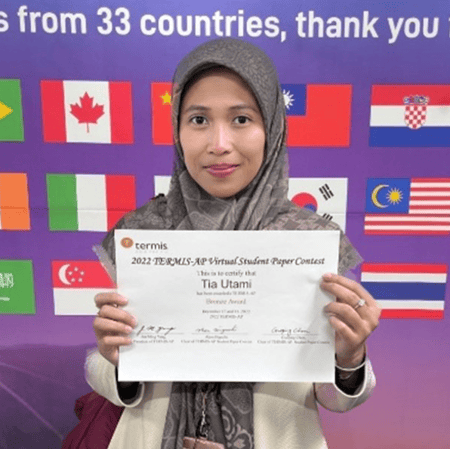TOPICS
- Award
- Award-Student
- 2023
Tia Utami (D3) received Bronze Award, 2022 TERMIS-AP Student Paper Contest
On 18th December 2022, Tia Utami (D3), Department of Bioengineering, received Bronze Award, 2022 TERMIS-AP (Tissue Engineering and Regenerative Medicine International Society, Asian-Pacific Capter) Student Paper Contest.

2022 TERMIS-AP (Tissue Engineering and Regenerative Medicine International Society, Asian-Pacific Capter) Student Paper Contest
This award is given to encourage the student to promote their research activity in tissue engineering and regenerative medicine in Asia and Pacific regions. The evaluation is based on the excellences in the delivering the research project and answer the question from the jury during discussion session. The bronze award is given to the 5th and 6th highest score of the student who is joined the paper contest, which are evaluated by the jury.
About awarded research
Liver transplantation is the only curative therapy for curing end-stage chronic liver diseases but is hampered by an important shortage of donors. Through recent technological advances in bioengineering, self-assembled human-induced pluripotent stem cells (hiPSCs)-derived liver organoids, appear as a promising alternative for clinical applic ation. Yet, the lack of tissue maturity remains a great challenge and restricts the potential of the technology for widespread applications. Therefore, an efficient method for generating functional liver organoids while enhancing tissue maturity is needed. Here, we generated homogenous liver organoids from hiPSCs-derived CPM+ LPCs using a microwell structure and targeted the improvement of maturation through direct oxygenation in oxygen-permeable culture vessels. Result indicate that improving the oxygen supply of cells through oxygen-permeable PDMS membranes is an efficient method for the generation of highly mature liver organoids composed of different cell populations.
Your impression & future plan
In the near future, the inclusion of non-parenchymal cell is needed to build up vascularized and more complex of liver organoids. Lastly, we consider in further study it may be possible to use our liver organoid for the preclinical testing of bioartificial devices and/or transplantation to treat animals affected by acute or chronic liver failure in potential anticipation of their use in the clinic.

